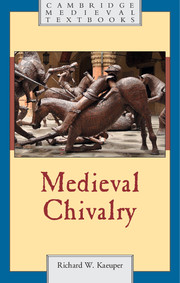Book contents
- Frontmatter
- Dedication
- Contents
- List of figures
- Acknowledgments
- Part I An approach to chivalry: was it real and practical?
- Part II Three broad chronological phases
- Part III The privileged practice of violence
- Part IV Chivalry, governing institutions, and ideals
- Part V The world of chivalric emotions
- 10 Love and amity, men and women
- 11 Anger, wrath, fear, thirst for vengeance
- Reflections
- Select Bibliography
- Index
11 - Anger, wrath, fear, thirst for vengeance
from Part V - The world of chivalric emotions
Published online by Cambridge University Press: 05 August 2016
- Frontmatter
- Dedication
- Contents
- List of figures
- Acknowledgments
- Part I An approach to chivalry: was it real and practical?
- Part II Three broad chronological phases
- Part III The privileged practice of violence
- Part IV Chivalry, governing institutions, and ideals
- Part V The world of chivalric emotions
- 10 Love and amity, men and women
- 11 Anger, wrath, fear, thirst for vengeance
- Reflections
- Select Bibliography
- Index
Summary
TAKING THE PULSE OF KNIGHTLY EMOTIONS
What might seem, from an idealistic modern perspective, a triumvirate of the nasty emotions – anger, wrath, and a thirst for vengeance, hot emotions working in tandem with their first cousin, icy fear – actually constituted sturdy pillars upholding structural elements of chivalric ideology. In fact, this daunting trident of emotions (with fear ever hovering) addressed basic chivalric concerns about acquiring and preserving honor and status and avoiding dread shame. The chivalric life, says Wolfram von Eschenbach in his Parzifal, gives two rich possessions to its practitioners: one is good faith (the loyalty we have repeatedly encountered); the other gift is “a true sense of the shame which brings honor, today as of old.”
Any challenge on these fronts could spark these emotions into living flame. As men obsessed with status and honor, knights knew they must show enemies – and also demonstrate to their fellow arms bearers in a competitive world – that they would not submit to any perceived debasement; that they would vigorously enact appropriate responses in order to secure social position; and that they, with a little help from friends, subordinates, or right-minded superiors in the military–tenurial hierarchy, would restore their corner of the world to its rightful state. In Middle High German, to take only one relevant case in point, the noun leit can mean not only sorrow, but insult and dishonor. Our sources thus focus on these emotions as correctives to intolerable challenges. And the case of fear provides the spur, showing deep worries about the possibility of loss.
That these powerful forces were abundantly active in the mental framework at the peak of elite lay society can readily be seen in the emotions and political actions of kings. Their vigorous personalities inspired or provoked a relatively rich supply of sources. Wrath, anger, and revenge functioned as expected and lauded royal traits. Their wrath easily enacted mini-dramas of power; their desire for vengeance could move armies. Contemporary medieval sources point to a furor Teutonicus, a rage in battle that marked German combat. With reason pushed aside, this battle fury could motivate fighters. Wrath was often, of course, displayed by individuals, especially those in power.
- Type
- Chapter
- Information
- Medieval Chivalry , pp. 353 - 383Publisher: Cambridge University PressPrint publication year: 2016



